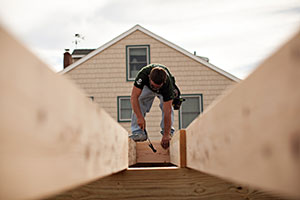Despite Slower May, Building Permits in Best Two-Month Stretch in Almost Eight Years

Builders in the United States began work on fewer houses in May after a surge the prior month, but the industry is having its best two months in almost eight years as its busiest time of year revs up.
While they declined 11.1% to a 1.04 million annualized rate in May, housing starts followed April’s revised 1.17 million pace to cap the best back-to-back readings since the last two months of 2007, the Commerce Department reported June 16.
The median estimate of 81 economists surveyed by Bloomberg News called for 1.09 million in May. Permits for future projects climbed to the highest level in almost eight years, indicating activity might pick up.
The data show the residential real estate market was sustaining gains after sporadic advances earlier in the year that reflected bad weather and a slump in overall U.S. growth. Hiring momentum and bigger paychecks amid still-cheap borrowing costs are brightening Americans’ moods and could lift home purchases in the second half of 2015.
“Affordability is still very good, so if you want to buy you can buy,” Stan Shipley, an economist at Evercore ISI in New York, said before the report. “Generally, we’re going to be climbing here.”
Estimates for starts in the Bloomberg survey ranged from 1.02 million to 1.16 million.
The 11.1% drop in housing starts last month followed a 22.1% surge in April that was the largest since January 1990 as the industry recovered from the bitter winter weather.
Building permits increased 11.8% to a 1.28 million annualized pace, the most since August 2007. They were projected to fall to 1.1 million, according to the Bloomberg survey median.
The starts data were in line with a report June 15 showing builder confidence rose in June to a nine-month high. Sentiment increased in an all four U.S. regions, and the sales outlook was the best since October 2005, the National Association of Home Builders/Wells Fargo gauge showed.
April housing data showed industry momentum was spotty at the start of the spring selling period. Purchases of new homes rose more than projected, increasing 6.8% to a 517,000 annualized pace from a 484,000 rate the prior month, according to Commerce Department figures.
Sales of existing homes unexpectedly fell 3.3% to a 5.04 million annualized rate after a 5.21 million pace in March that was the strongest in almost two years, National Association of Realtors figures showed.
Relatively cheap borrowing costs are still supporting homebuyers. The average rate on a 30-year fixed mortgage was 4.04% in the week ended June 11, according to data from Freddie Mac in McLean, Virginia. That’s still below the average 6.06% in the last five years of the economic expansion that ended in December 2007, when the housing market boomed.
Further labor-market progress should keep up expectations for gains in housing and the broader economy. Employers added 280,000 jobs in May, the most in five months, after a 221,000 April advance. An increase in the number of people entering the labor force caused the jobless rate to creep up to 5.5% from 5.4%, which was the lowest since May 2008.
Wage growth also has begun to show signs of life. Average pay for all civilian workers climbed 4.2% in the first quarter from the same period in 2014 to $22.88 an hour, Labor Department figures showed last week. That compares with a 4% year-over-year gain in the fourth quarter and is the strongest since July-September 2006.
Average hourly earnings reported with the Labor Department’s monthly jobs figures accelerated in May to a 2.3% year-over-year pace, the fastest since August 2013.
Advances in hiring and wages are keeping executives at Mooresville, North Carolina-based Lowe’s Cos. positive about sales prospects.
“We’ve got modestly improving wages, so the income environment is constructive for home improvement,” Chief Financial Officer Robert Hull said at a June 10 conference hosted by Piper Jaffray Cos. “We need a good, stable, employment base, which we’ve got today.”
More gains in the housing industry will be important in sustaining economic growth as factory production slows. Output unexpectedly declined in May as the slump in energy production deepened, Federal Reserve figures showed June 15.
The 0.2% decrease at manufacturers followed a 0.1% increase in April, the Fed data showed. Total industrial production, which adds mines and utilities, dropped 0.2%.

